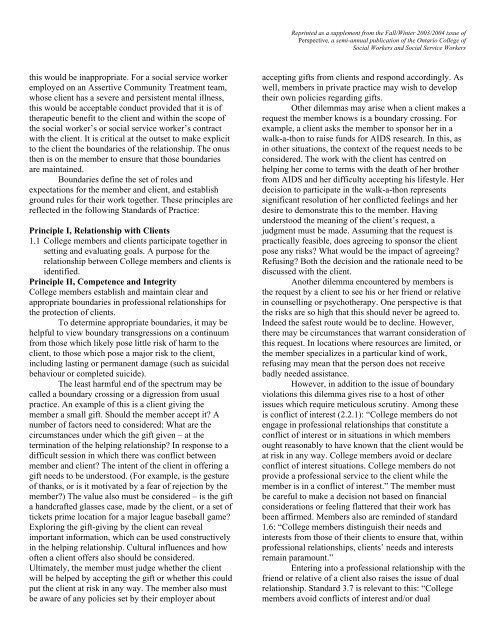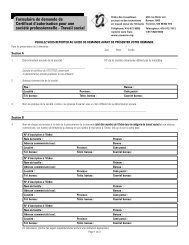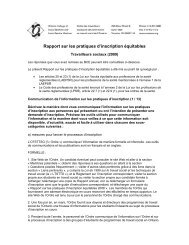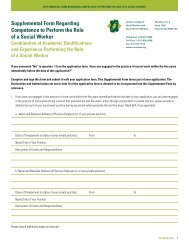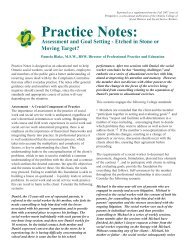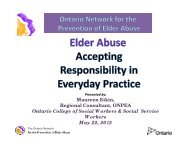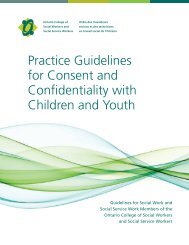Boundary Violations - Ontario College of Social Workers and Social ...
Boundary Violations - Ontario College of Social Workers and Social ...
Boundary Violations - Ontario College of Social Workers and Social ...
You also want an ePaper? Increase the reach of your titles
YUMPU automatically turns print PDFs into web optimized ePapers that Google loves.
Reprinted as a supplement from the Fall/Winter 2003/2004 issue <strong>of</strong><br />
Perspective, a semi-annual publication <strong>of</strong> the <strong>Ontario</strong> <strong>College</strong> <strong>of</strong><br />
<strong>Social</strong> <strong>Workers</strong> <strong>and</strong> <strong>Social</strong> Service <strong>Workers</strong><br />
this would be inappropriate. For a social service worker<br />
employed on an Assertive Community Treatment team,<br />
whose client has a severe <strong>and</strong> persistent mental illness,<br />
this would be acceptable conduct provided that it is <strong>of</strong><br />
therapeutic benefit to the client <strong>and</strong> within the scope <strong>of</strong><br />
the social worker’s or social service worker’s contract<br />
with the client. It is critical at the outset to make explicit<br />
to the client the boundaries <strong>of</strong> the relationship. The onus<br />
then is on the member to ensure that those boundaries<br />
are maintained.<br />
Boundaries define the set <strong>of</strong> roles <strong>and</strong><br />
expectations for the member <strong>and</strong> client, <strong>and</strong> establish<br />
ground rules for their work together. These principles are<br />
reflected in the following St<strong>and</strong>ards <strong>of</strong> Practice:<br />
Principle I, Relationship with Clients<br />
1.1 <strong>College</strong> members <strong>and</strong> clients participate together in<br />
setting <strong>and</strong> evaluating goals. A purpose for the<br />
relationship between <strong>College</strong> members <strong>and</strong> clients is<br />
identified.<br />
Principle II, Competence <strong>and</strong> Integrity<br />
<strong>College</strong> members establish <strong>and</strong> maintain clear <strong>and</strong><br />
appropriate boundaries in pr<strong>of</strong>essional relationships for<br />
the protection <strong>of</strong> clients.<br />
To determine appropriate boundaries, it may be<br />
helpful to view boundary transgressions on a continuum<br />
from those which likely pose little risk <strong>of</strong> harm to the<br />
client, to those which pose a major risk to the client,<br />
including lasting or permanent damage (such as suicidal<br />
behaviour or completed suicide).<br />
The least harmful end <strong>of</strong> the spectrum may be<br />
called a boundary crossing or a digression from usual<br />
practice. An example <strong>of</strong> this is a client giving the<br />
member a small gift. Should the member accept it A<br />
number <strong>of</strong> factors need to considered: What are the<br />
circumstances under which the gift given – at the<br />
termination <strong>of</strong> the helping relationship In response to a<br />
difficult session in which there was conflict between<br />
member <strong>and</strong> client The intent <strong>of</strong> the client in <strong>of</strong>fering a<br />
gift needs to be understood. (For example, is the gesture<br />
<strong>of</strong> thanks, or is it motivated by a fear <strong>of</strong> rejection by the<br />
member) The value also must be considered – is the gift<br />
a h<strong>and</strong>crafted glasses case, made by the client, or a set <strong>of</strong><br />
tickets prime location for a major league baseball game<br />
Exploring the gift-giving by the client can reveal<br />
important information, which can be used constructively<br />
in the helping relationship. Cultural influences <strong>and</strong> how<br />
<strong>of</strong>ten a client <strong>of</strong>fers also should be considered.<br />
Ultimately, the member must judge whether the client<br />
will be helped by accepting the gift or whether this could<br />
put the client at risk in any way. The member also must<br />
be aware <strong>of</strong> any policies set by their employer about<br />
accepting gifts from clients <strong>and</strong> respond accordingly. As<br />
well, members in private practice may wish to develop<br />
their own policies regarding gifts.<br />
Other dilemmas may arise when a client makes a<br />
request the member knows is a boundary crossing. For<br />
example, a client asks the member to sponsor her in a<br />
walk-a-thon to raise funds for AIDS research. In this, as<br />
in other situations, the context <strong>of</strong> the request needs to be<br />
considered. The work with the client has centred on<br />
helping her come to terms with the death <strong>of</strong> her brother<br />
from AIDS <strong>and</strong> her difficulty accepting his lifestyle. Her<br />
decision to participate in the walk-a-thon represents<br />
significant resolution <strong>of</strong> her conflicted feelings <strong>and</strong> her<br />
desire to demonstrate this to the member. Having<br />
understood the meaning <strong>of</strong> the client’s request, a<br />
judgment must be made. Assuming that the request is<br />
practically feasible, does agreeing to sponsor the client<br />
pose any risks What would be the impact <strong>of</strong> agreeing<br />
Refusing Both the decision <strong>and</strong> the rationale need to be<br />
discussed with the client.<br />
Another dilemma encountered by members is<br />
the request by a client to see his or her friend or relative<br />
in counselling or psychotherapy. One perspective is that<br />
the risks are so high that this should never be agreed to.<br />
Indeed the safest route would be to decline. However,<br />
there may be circumstances that warrant consideration <strong>of</strong><br />
this request. In locations where resources are limited, or<br />
the member specializes in a particular kind <strong>of</strong> work,<br />
refusing may mean that the person does not receive<br />
badly needed assistance.<br />
However, in addition to the issue <strong>of</strong> boundary<br />
violations this dilemma gives rise to a host <strong>of</strong> other<br />
issues which require meticulous scrutiny. Among these<br />
is conflict <strong>of</strong> interest (2.2.1): “<strong>College</strong> members do not<br />
engage in pr<strong>of</strong>essional relationships that constitute a<br />
conflict <strong>of</strong> interest or in situations in which members<br />
ought reasonably to have known that the client would be<br />
at risk in any way. <strong>College</strong> members avoid or declare<br />
conflict <strong>of</strong> interest situations. <strong>College</strong> members do not<br />
provide a pr<strong>of</strong>essional service to the client while the<br />
member is in a conflict <strong>of</strong> interest.” The member must<br />
be careful to make a decision not based on financial<br />
considerations or feeling flattered that their work has<br />
been affirmed. Members also are reminded <strong>of</strong> st<strong>and</strong>ard<br />
1.6: “<strong>College</strong> members distinguish their needs <strong>and</strong><br />
interests from those <strong>of</strong> their clients to ensure that, within<br />
pr<strong>of</strong>essional relationships, clients’ needs <strong>and</strong> interests<br />
remain paramount.”<br />
Entering into a pr<strong>of</strong>essional relationship with the<br />
friend or relative <strong>of</strong> a client also raises the issue <strong>of</strong> dual<br />
relationship. St<strong>and</strong>ard 3.7 is relevant to this: “<strong>College</strong><br />
members avoid conflicts <strong>of</strong> interest <strong>and</strong>/or dual


